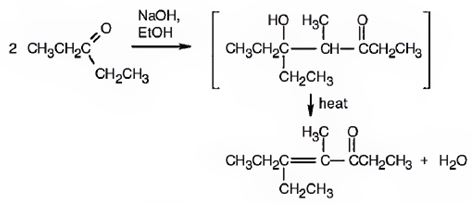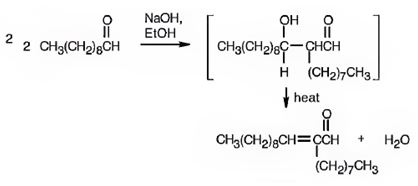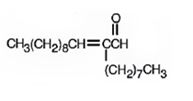
Concept explainers
a)

Interpretation:
Whether trimethylacetaldehyde undergoes aldol self-condensation reaction or not is to be stated. The product formed, if the reaction is successful, is also to be shown.
Concept introduction:
To state:
Whether trimethylacetaldehyde undergoes aldol self-condensation reaction or not.
To show:
The product formed, if the reaction is successful.
Answer to Problem 48AP
Trimethylacetaldehyde does not undergo aldol self-condensation reaction. The reaction is not successful.
Explanation of Solution
The requirement of aldol reaction is the aldehyde or ketone should have α-hydrogen atom. Trimethylacetaldehyde does not possess α-hydrogen atom. Hence the reaction is not successful.
Trimethylacetaldehyde does not undergo aldol self-condensation reaction. The reaction is not successful.
b)

Interpretation:
Whether cyclobutanone undergoes aldol self-condensation reaction or not is to be stated. The product formed, if the reaction is successful, is also to be shown.
Concept introduction:
Aldehydes and ketones with α-hydrogen undergo a base catalyzed carbonyl condensation reaction in aldol condensation. In this reaction two molecules of the reactant combine by forming a bond between α-carbon of one molecule and the carbonyl carbon within the same molecule or of the second molecule.
To state:
Whether cyclobutanone undergoes aldol self-condensation reaction or not.
To show:
The product formed, if the reaction is successful.
Answer to Problem 48AP
Cyclobutanone undergoes aldol self-condensation reaction. The product formed is

Explanation of Solution
The requirement of aldol reaction is the aldehyde or ketone should have α-hydrogen atom. Cyclobutanone has α-hydrogen atoms. Hence the reaction is successful. Two molecules of cyclobutanone condense in the presence of a base to yield an aldol which dehydrates to give α, β-unsaturated ketone.

Cyclobutanone undergoes aldol self-condensation reaction. The product formed is

c)

Interpretation:
Whether benzophenone undergoes aldol self-condensation reaction or not is to be stated. The product formed, if the reaction is successful, is also to be shown.
Concept introduction:
Aldehydes and ketones with α-hydrogen undergo a base catalyzed carbonyl condensation reaction in aldol condensation. In this reaction two molecules of the reactant combine by forming a bond between α-carbon of one molecule and the carbonyl carbon within the same molecule or of the second molecule.
To state:
Whether benzophenone undergoes aldol self-condensation reaction or not.
To show:
The product formed, if the reaction is successful.
Answer to Problem 48AP
Benzophenone does not undergo self aldol condensation reaction. The reaction is not successful.
Explanation of Solution
The requirement of aldol reaction is the aldehyde or ketone should have α-hydrogen atom. Benzophenone does not possess α-hydrogen atom. Hence the reaction is not successful.
Benzophenone does not undergo self aldol condensation reaction. Theb reaction is not successful.
d)

Interpretation:
Whether 3-pentanone undergoes aldol self-condensation reaction or not is to be stated. The product formed, if the reaction is successful, is also to be shown.
Concept introduction:
Aldehydes and ketones with α-hydrogen undergo a base catalyzed carbonyl condensation reaction in aldol condensation. In this reaction two molecules of the reactant combine by forming a bond between α-carbon of one molecule and the carbonyl carbon within the same molecule or of the second molecule.
To state:
Whether 3-pentanone undergoes aldol self-condensation reaction or not.
To show:
The product formed, if the reaction is successful.
Answer to Problem 48AP
3-pentanone undergoes aldol self-condensation reaction. The product formed is

Explanation of Solution
The requirement of aldol reaction is the aldehyde or ketone should have α-hydrogen atom. 3-Pentanone has α-hydrogen atom. Hence the reaction is successful. Two molecules of 3-pentanone condense in the presence of a base to yield an aldol which dehydrates to give the α, β-unsaturated ketone.

3-pentanone undergoes aldol self-condensation reaction. The product formed is

e)

Interpretation:
Whether decanal undergoes aldol self-condensation reaction or not is to be stated. The product formed, if the reaction is successful, is also to be shown.
Concept introduction:
Aldehydes and ketones with α-hydrogen undergo a base catalyzed carbonyl condensation reaction in aldol condensation. In this reaction two molecules of the reactant combine by forming a bond between α-carbon of one molecule and the carbonyl carbon within the same molecule or of the second molecule.
To state:
Whether decanal undergoes aldol self-condensation reaction or not.
To show:
The product formed, if the reaction is successful.
Answer to Problem 48AP
Decanal undergoes aldol self-condensation reaction. The product formed is

Explanation of Solution
The requirement of aldol reaction is the aldehyde or ketone should have α-hydrogen atom. Decanal has α-hydrogen atom. Hence the reaction is successful. Two molecules of decanal condense in the presence of a base to yield an aldol which dehydrates to give an α, β-unsaturated aldehyde.

Decanal undergoes aldol self-condensation reaction. The product formed is

f)

Interpretation:
Whether 3-phenyl-2-propenal undergoes aldol self-condensation reaction or not is to be stated. The product formed, if the reaction is successful, is also to be shown.
Concept introduction:
Aldehydes and ketones with α-hydrogen undergo a base catalyzed carbonyl condensation reaction in aldol condensation. In this reaction two molecules of the reactant combine by forming a bond between α-carbon of one molecule and the carbonyl carbon within the same molecule or of the second molecule.
To state:
Whether 3-phenyl-2-propenal undergoes aldol self-condensation reaction or not.
To show:
The product formed, if the reaction is successful.
Answer to Problem 48AP
3-Phenyl-2-propenal does not undergo aldol self-condensation reaction. The reaction is not successful.
Explanation of Solution
The requirement of aldol reaction is the aldehyde or ketone should have α-hydrogen atom. 3-Phenyl-2-propenal does not possess α-hydrogen atom. Hence the reaction is not successful.
3-Phenyl-2-propenal does not undergo aldol self-condensation reaction. The reaction is not successful.
Want to see more full solutions like this?
Chapter 23 Solutions
Organic Chemistry
- elow are experimentally determined van Deemter plots of column efficiency, H, vs. flow rate. H is a quantitative measurement of band broadening. The left plot is for a liquid chromatography application and the night is for gas chromatography. Compare and contrast these two plots in terms of the three band broadening mechanisms presented in this activity. How are they similar? How do they differ? Justify your answers.? 0.4 H (mm) 0.2 0.1- 0.3- 0 0.5 H (mm) 8.0 7.0 6.0 5.0 4.0- 3.0 T +++ 1.0 1.5 0 2.0 4.0 Flow Rate, u (cm/s) 6.0 8.0 Flow Rate, u (cm/s)arrow_forwardPredict the products of this organic reaction: + H ZH NaBH3CN H+ n. ? Click and drag to start drawing a structure. Xarrow_forwardWhat is the missing reactant R in this organic reaction? + R H3O+ + • Draw the structure of R in the drawing area below. • Be sure to use wedge and dash bonds if it's necessary to draw one particular enantiomer. Click and drag to start drawing a structure.arrow_forward
- What would be the best choices for the missing reagents 1 and 3 in this synthesis? 1 1. PPh3 2. n-BuLi 2 • Draw the missing reagents in the drawing area below. You can draw them in any arrangement you like. • Do not draw the missing reagent 2. If you draw 1 correctly, we'll know what it is. • Note: if one of your reagents needs to contain a halogen, use bromine. Click and drag to start drawing a structure.arrow_forwardThe product on the right-hand side of this reaction can be prepared from two organic reactants, under the conditions shown above and below the arrow. Draw 1 and 2 below, in any arrangement you like. 1+2 NaBH₂CN H+ N Click and drag to start drawing a structure. X $arrow_forwardExplain what is the maximum absorbance of in which caffeine absorbs?arrow_forward
- Explain reasons as to why the amount of caffeine extracted from both a singular extraction (5ml Mountain Dew) and a multiple extraction (2 x 5.0ml Mountain Dew) were severely high when compared to coca-cola?arrow_forwardProtecting Groups and Carbonyls 6) The synthesis generates allethrolone that exhibits high insect toxicity but low mammalian toxicity. They are used in pet shampoo, human lice shampoo, and industrial sprays for insects and mosquitos. Propose detailed mechanistic steps to generate the allethrolone label the different types of reagents (Grignard, acid/base protonation, acid/base deprotonation, reduction, oxidation, witting, aldol condensation, Robinson annulation, etc.) III + VI HS HS H+ CH,CH,Li III I II IV CI + P(Ph)3 V ༼ Hint: no strong base added VI S VII IX HO VIII -MgBr HgCl2,HgO HO. isomerization aqeuous solution H,SO, ༽༽༤༽༽ X MeOH Hint: enhances selectivity for reaction at the S X ☑arrow_forwardDraw the complete mechanism for the acid-catalyzed hydration of this alkene. esc 田 Explanation Check 1 888 Q A slock Add/Remove step Q F4 F5 F6 A བྲA F7 $ % 5 @ 4 2 3 & 6 87 Click and drag to start drawing a structure. © 2025 McGraw Hill LLC. All Rights Reserved. Terms of Use | Privacy Ce W E R T Y U S D LL G H IK DD 요 F8 F9 F10 F1 * ( 8 9 0 O P J K L Z X C V B N M H He commandarrow_forward
- Explanation Check F1 H₂O H₂ Pd 1) MCPBA 2) H3O+ 1) Hg(OAc)2, H₂O 2) NaBH4 OH CI OH OH OH hydration halohydrin formation addition halogenation hydrogenation inhalation hydrogenation hydration ☐ halohydrin formation addition halogenation formation chelation hydrogenation halohydrin formation substitution hydration halogenation addition Ohalohydrin formation subtraction halogenation addition hydrogenation hydration F2 80 F3 σ F4 F5 F6 1 ! 2 # 3 $ 4 % 05 Q W & Å © 2025 McGraw Hill LLC. All Rights Reserved. F7 F8 ( 6 7 8 9 LU E R T Y U A F9arrow_forwardShow the mechanism steps to obtain the lowerenergy intermediate: *see imagearrow_forwardSoap is made by the previous reaction *see image. The main difference between one soap and another soap isthe length (number of carbons) of the carboxylic acid. However, if a soap irritates your skin, they mostlikely used too much lye.Detergents have the same chemical structure as soaps except for the functional group. Detergentshave sulfate (R-SO4H) and phosphate (R-PO4H2) functional groups. Draw the above carboxylic acidcarbon chain but as the two variants of detergents. *see imagearrow_forward
 Organic ChemistryChemistryISBN:9781305580350Author:William H. Brown, Brent L. Iverson, Eric Anslyn, Christopher S. FootePublisher:Cengage Learning
Organic ChemistryChemistryISBN:9781305580350Author:William H. Brown, Brent L. Iverson, Eric Anslyn, Christopher S. FootePublisher:Cengage Learning

